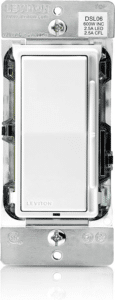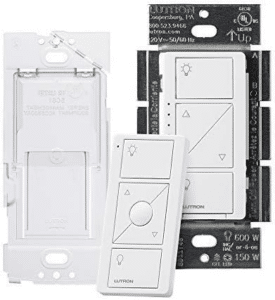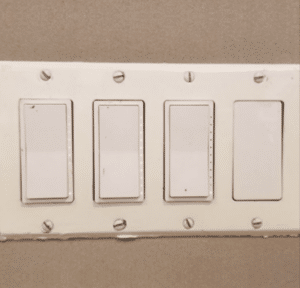Introduction – Leviton vs Lutron Smart Switches
Light switches have evolved beyond the traditional toggle, with advancements led by companies such as Leviton and Lutron. These brands have introduced a range of smart switches, designed not only for illumination but also for integrating into smart home ecosystems. This article we explore Lutron vs Leviton Smart Switches from our own writers’ testing of the two smart switches, focusing on their ease of use, compatibility, installation process, price, and environmental impact. Both types are interoperable as Alexa light switches.


Leviton Smart Switches
Leviton, a company with a long history in electrical wiring devices, offers the Decora Smart Wi-Fi Switch. This switch integrates with Amazon Alexa and Google Assistant and features voice control, scheduling, and automation capabilities. Made from durable materials, it also aims for energy efficiency.
Lutron Smart Switches
Lutron, known for introducing the first electronic dimmer switch, offers the Caséta Wireless system. This system allows light control via a smartphone app, voice-activated assistants, and manual control. Optimized for LED lights, it supports a range of bulbs and offers personalized dimming levels.
Lutron vs Leviton Smart Switches: Side-by-Side Comparison
Leviton and Lutron provide different features that may appeal to varying consumer preferences. For example, Leviton’s Decora Smart Wi-Fi Switch, priced around $40, may appeal to budget-conscious consumers, whereas Lutron’s Caséta Wireless In-Wall Switch, at approximately $55, offers extensive smart home network compatibility and an advanced dimming system. A comprehensive cost-benefit analysis factoring in long-term energy savings would aid in making a more informed choice.
Leviton Decora vs. Lutron Caseta: A Comparision Review
When it comes to choosing smart switches for a home automation system, two names often come up: Leviton Decora and Lutron Caseta. Both brands have their loyalists, and each offers distinct features and experiences. ShrinkThatFootprint assigned two writers the task of setting up on instance each of the Leviton Decora and Lutron Caseta, and compared notes. The result is as follows.
Design and User Interface: Leviton Decora sticks to the traditional rocker-style design, which we found familiar and user-friendly. This classic approach appeals to those who prefer a standard look and feel in their switch controls.

On the other hand, Lutron Caseta switches offer a unique design. They feature a distinct button layout that, while initially requiring some acclimatization, becomes intuitive over time. However, the appearance of these switches, especially when installed alongside Pico remotes in multi-gang configurations, is a matter of personal preference.
Reliability and Performance: Lutron Caseta scores highly on reliability. We report exceptional performance, noting its seamless integration with Google Home.
The consistent operation of Lutron switches, without frequent reboots or connectivity issues, was a highlight. Leviton Decora also performed well, especially when integrated with systems like WebCoRE and Home Assistant. However, others report occasional mentions of connectivity issues, particularly with Wi-Fi reliability.
Installation and Compatibility: Ease of installation is a significant plus for Lutron Caseta, particularly for those who already have a Lutron bridge. The simplicity of setting up 3-way switches with Pico remotes is often cited as an advantage.
Leviton’s installation process is also well-regarded, with one of us having to call the company’s technical support, which turned out to be quite responsive for a unique wiring scenario.
Network Considerations: A notable distinction is the communication protocol used by each brand. Leviton’s Wi-Fi-based system may add to the load on a home’s wireless network, which could be a concern in heavily connected homes. However, we didn’t have any problems.
Lutron, using its ClearConnect protocol, avoided the issue by offering a dedicated and reliable connection without taxing the home’s Wi-Fi network.
Aesthetics and Integration: The aesthetic aspect is subjective but important. We found Lutron’s design and the look of its Pico remotes modern and stylish, while others express reservations about their appearance in multi-switch settings.
Leviton’s traditional design is often viewed as more seamlessly integrating into a variety of home environments.
Product Range and Features: Lutron offers other options, including the Caseta line and higher-tier choices like RA2 Select, catering to different needs and preferences. Leviton’s has a narrower range of products, but its general reliability and quality customer service are frequently highlighted.
Cost and Value: Cost considerations vary. We note Lutron has higher-priced models but believe the cost is justified by the quality and feature set. We’re less worried about Leviton’s cost because its value is recognized in terms of reliability and design familiarity.
Conclusion: Which is the Best Smart Switch?
The decision between Leviton and Lutron smart switches will depend on individual needs and priorities. Factors like budget, desired features, compatibility with existing smart home systems, and commitment to energy efficiency will guide this choice.

It’s important for consumers to consider the total cost of ownership, including initial investment and potential energy savings, when selecting a smart switch.
The Role of Smart Switches in Carbon Reduction and Sustainability
Smart home devices, including smart switches, provide an opportunity for energy efficiency and reducing carbon footprints. By optimizing energy use and providing intelligent control, these devices can play a part in sustainable living.
Leviton offers products like the Decora Smart LED Dimmer with occupancy sensors, and Lutron has the Caséta Wireless in-wall dimmer, both aimed at energy conservation. However, a detailed analysis of their full environmental impact, from manufacturing to end-of-life disposal, is not provided in this article.
References
This comparison also draws from our research on articles from TechHive, Wirecutter, CNET, and user reviews from Amazon. While these sources provide valuable insights, readers are encouraged to consider additional independent research to make an informed decision tailored to their specific requirements.
